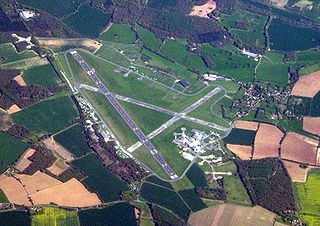
Hang gliding is an air sport or recreational activity in which a pilot flies a light, non-motorised, heavier-than-air aircraft called a hang glider. Most modern hang gliders are made of an aluminium alloy or composite frame covered with synthetic sailcloth to form a wing. Typically the pilot is in a harness suspended from the airframe, and controls the aircraft by shifting body weight in opposition to a control frame.

Alan Derek Piggott was one of Britain's best known glider pilots and instructors. He had over 5,000 hours on over 153 types of powered aircraft and over 5,000 hours on over 184 types of glider. He was honoured for his work on the instruction and safety of glider pilots. In 1961 he became the first person to make an officially authenticated take-off and flight in a man-powered aircraft. He also worked as a stunt pilot in several feature films.
The British Gliding Association (BGA) is the governing body for gliding in the United Kingdom. Gliding in the United Kingdom operates through 80 gliding clubs which have 2,310 gliders and 9,462 full flying members, though a further 17,000 people have gliding air-experience flights each year.

The London Gliding Club (LGC) is a members' club whose airfield is located at the foot of the Dunstable Downs. Many privately owned gliders are based there. It has the facilities to train pilots in powerless flight, and in the skills necessary to fly cross country using nature's sources of energy. Aerobatics and instructor training are also available. The LGC is open 364 days a year and is the second largest and one of the oldest Gliding Clubs in the United Kingdom, smaller only than Lasham Gliding Society. The club provides gliding courses, one day courses and trial lessons for members of the public.
Sport at the University of Adelaide is primarily organised by the Adelaide University Sports Association. Other bodies affiliated to the University of Adelaide providing sport include the various sports clubs forming part of the residential colleges and the Roseworthy Agricultural Campus Student Union Council.

The Scottish Gliding Union is the largest gliding club in Scotland. The body is based at Portmoak Airfield, Scotlandwell, KY13 9JJ.
The Gliding Federation of Australia (GFA), also known as Gliding Australia, is the governing body for the sport of gliding in Australia. It was founded in 1949. The GFA is responsible to Civil Aviation Safety Authority for the conduct of safe gliding operations in Australia. This includes the setting and maintenance of flying standards and in particular training standards, for gliding and soaring flight in heavier-than-air fixed-wing gliders and sailplanes, powered sailplanes and touring motor gliders, but excluding flexible wing, weight shift hang gliders and paragliders.

The G103 Twin II is a high-performance two-seat sailplane manufactured in Germany by Grob Aircraft. The aircraft is of T-tail configuration, and is fitted with upper-surface airbrakes and a non-retractable undercarriage. Of fiberglass construction, it is designed for training, high performance cross-country racing and simple aerobatic flying.

A glider is a fixed-wing aircraft that is supported in flight by the dynamic reaction of the air against its lifting surfaces, and whose free flight does not depend on an engine. Most gliders do not have an engine, although motor-gliders have small engines for extending their flight when necessary by sustaining the altitude with some being powerful enough to take off by self-launch.
The Cotswold Gliding Club (CGC) is based at Aston Down airfield, between Cirencester and Stroud in Gloucestershire, South West England. The club maintains a fleet of aircraft for training purposes, and is a centre for cross-country gliding and competitions.
Ingo Renner OAM was an Australian glider pilot. He won the World Gliding Championships four times.
The British Aircraft Company was a British aircraft manufacturer based in Maidstone. It was founded by C H Lowe-Wylde and produced gliders and light aircraft during the 1930s.

Rear Admiral Hilary Charles Nicholas Goodhart CB FRAeS was an engineer and aviator who invented the mirror-sight deck landing system for aircraft carriers. He was also a world champion and record breaker in gliding.

Gliding is a recreational activity and competitive air sport in which pilots fly unpowered aircraft known as gliders or sailplanes using naturally occurring currents of rising air in the atmosphere to remain airborne. The word soaring is also used for the sport.

A glider or sailplane is a type of glider aircraft used in the leisure activity and sport of gliding. This unpowered aircraft can use naturally occurring currents of rising air in the atmosphere to gain altitude. Sailplanes are aerodynamically streamlined and so can fly a significant distance forward for a small decrease in altitude.
Frank Irving was a British aeronautical engineer, glider pilot, author and university lecturer.

Lasham Airfield is an aerodrome 3.6 miles (5.8 km) north-west of Alton in Hampshire, England, in the village of Lasham.

The Royal Air Force Gliding & Soaring Association (RAFGSA) is a voluntary organisation which exists to provide recreational flying to all RAF servicemen and women, in particular those employed in ground duties.
Oxford Gliding Club (OGC) is a UK gliding club, and is one of the oldest still in operation in the UK. Currently it operates from RAF Weston-on-the-Green, north of Oxford. In 2012, the club celebrated its 75th anniversary.
Helen Naomi Heron-Maxwell was a British woman parachutist and glider in the 1930s. She was the first woman glider pilot in the United Kingdom to achieve the Silver-C badge. She promoted gliding and helped to establish gliding clubs. She was a ferry pilot for the Air Transport Auxiliary in the Second World War.










